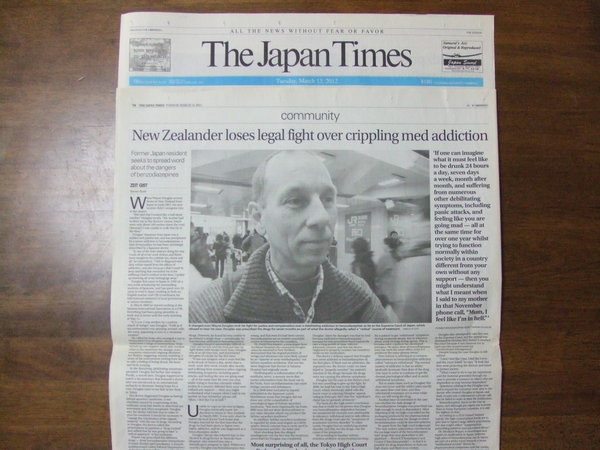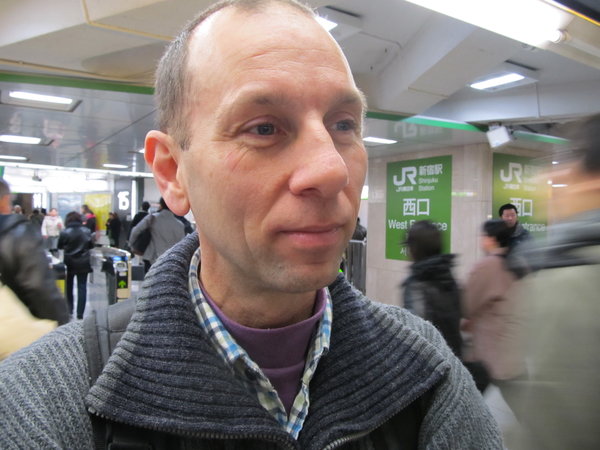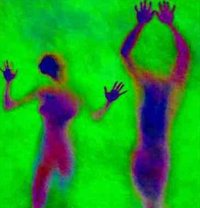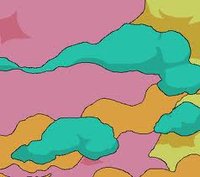The Japan Times - Feature Article

Notice
This news article was published by THE JAPAN TIMES on March 13, 2012. Included are some clarifying comments from me at the very end.
The Japan Times
Tuesday, March 13, 2012
New Zealander loses legal fight over crippling med addiction
― Former Japan resident seeks to spread word about the dangers of benzodiazepines ―
By SIMON SCOTT

A changed man: Wayne Douglas took his fight for justice and compensation over a debilitating addiction to benzodiazepines as far as the Supreme Court of Japan, which refused to hear his case. Douglas was prescribed the drugs for seven months as part of what the doctor allegedly called a "radical" course of treatment.
By SIMON SCOTT
Top of Page
(The Impact)
When Wayne Douglas arrived home in New Zealand from Japan in early 2001, his own mother didn't recognize him at the airport.
"She said that I looked like a half-dead zombie," Douglas recalls. "My mother had to drive me to the doctors' rooms, which were only about 100 meters down the road, (because) I was unable to walk that far at the time."
Douglas' departure from Japan was a sudden and painful one, and was precipitated by a severe addiction to benzodiazepines, a type of tranquilizer he had been unwittingly prescribed by a Japanese doctor.
"In one of the train stations along the way I took off all of my work clothes and threw them straight in the rubbish bin, shoes and all," he remembers. "I felt so disgusted and dirty within myself from the effects of addiction, and also because I didn't want to keep anything that reminded me of the suffering I had to endure at the time, I ended up throwing all of my belongings away." In addition, his addiction to prescription drugs weakened his body to such a degree that even carrying a light load was too much for him.
Top of Page
(Road to Dependency)
Douglas first came to Japan in 1992 on a two-week scholarship for outstanding students of Japanese, and has spent over 10 years in total in Japan working as both an English teacher and CIR (coordinator for international relations) in local government at various locations.
In March 2000 he started working at the Saitama International Association as a CIR. Everything had been going smoothly at work and at home until the early morning of May 11.
"At 2 a.m. I was awoken by a sudden attack of vertigo," says Douglas. "It felt as if my environment was spinning around, with the room appearing to turn in a clockwise rotation."
He called his boss, who arranged a taxi to Omiya Red Cross Hospital, where he underwent a range of examinations. Tests turned up one negative result after another, while in the meantime the strange, scary symptoms continued: ongoing dizziness, hot flushes, staggering, nausea, vomiting, a sense of the environment rocking from side to side, a feeling of being drunk, his head and body swaying.
"I tended to veer off to the left when walking and it felt like someone was pushing me to the left," explains Douglas. "It seemed as though I was viewing my environment through a camcorder when walking."
As the disturbing, debilitating symptoms persisted, Douglas fell further into despair. Finally, a month later, Douglas happened to watch a television documentary that featured a doctor who was introduced as an international authority in dizziness. Seeing hope for a cure, Douglas went to see him at his clinic in Tokyo.
The doctor diagnosed Douglas as having Sylvian aqueduct syndrome, a rare condition caused by a narrowing of the midbrain canal that results in abnormal eye movement and other symptoms. Douglas says the doctor told him that in order to treat his condition it would be necessary to "change the constitution of his organic makeup" with the use of drugs. According to Douglas, the doctor called the prescriptions in question a "drug cocktail" and added that he was going to take "a radical approach" to his treatment.
Top of Page
(The Doctor's Treatment and What Happened Next)
Wayne was prescribed five different drugs — three benzodiazepine tranquilizers (Contol, Rivotril and Grandaxin), a tricyclic antidepressant called Tofranil (imipramine) and a type of anti-inflammatory (ibudilast) marketed as Ketas. Douglas says he received no explanation from the doctor about the nature of the drugs.
"I decided to take the liberty of asking if they had any side-effects, as a precautionary measure. (The doctor) answered by saying, 'All drugs have some side-effects, but these are nonaddictive drugs in small doses with little side-effects, so you needn't worry about taking them over long periods of time.' "
Douglas knew nothing about benzodiazepines at the time, and as the doctor was an respected expert on balance disorders, he accepted his judgment in good faith.
After the first couple of weeks of treatment, Douglas experienced a noticeable improvement in his condition (*1) and a settling of the more severe symptoms he had been experiencing, so he continued taking the prescriptions.
Unfortunately for Douglas, this progress was short-lived, and by late August — less than two months after beginning treatment — his condition had begun to deteriorate again. By the four-month mark — the point when the doctor said he should expect to have fully recovered — his dizziness was markedly worse than before treatment (*2).
"I was left in a state where I was constantly staggering, like being quite drunk." And disturbingly, he also began experiencing new symptoms.
"I began to suffer from severe emotional instability including panic attacks, anxiety, mood swings, aggression, and feelings that I was going mad.
"This is the first time I had ever experienced anything like this, and it still remains with me (*3). I felt afraid of being diagnosed as mentally unwell and sent off to an institution in a country different from my own, never to come out again."
By November 2000, Douglas had begun to lose faith in the doctor and his treatment and decided to stop taking the prescribed drugs. However, he found he was unable to go without a single dose — unwittingly, he had become addicted to benzodiazepines.
Douglas began to find it increasingly difficult to carry out his job, and his boss put him on light duties with breaks every hour. Douglas was at an all-time low, and entertained thoughts of suicide for the first time.
"If one can imagine what it must feel like to be drunk 24 hours a day, seven days a week, week after week, month after month, and suffering from numerous other ongoing debilitating symptoms, including panic attacks, and feeling like you are going mad all at the same time for over one year, whilst trying to function normally within society in a country different from your own without any support — then you might understand what I meant when I said to my mother in that November phone call, 'Mum, I feel like I'm in hell.' "
Unable to cope on his own in Japan, Douglas eventually made the decision to return to New Zealand in March 2001. It was only when he visited his local doctor back home that Douglas learned for the first time that the drugs he had been given in Japan were highly addictive, and he was diagnosed as a benzodiazepine addict.
Douglas' doctor also referred him to the Alcohol & Drug Service at Taranaki Base Hospital, who entered him into a detoxification program in April. Within two months, Douglas was benzodiazepine-free.
Yet his life was far from back to normal. It took another year before he was cleared by his doctor to work again, and even to this day — over a decade later — he says he is still suffering from some of the residual emotional effects of his addiction, such as depression, chronic anxiety and panic attacks (*4).
"I found thereafter that, because of these panic attacks, my ability to carry out normal employment had diminished considerably, and subsequently I was unable to apply for jobs that matched my qualifications and experience," he explains. "So I ended up having to apply for low-paying jobs, and even then, on occasion I would end up unemployed again, as I often became easily fatigued."
Top of Page
(Realizing Treatment Was Wrong)
Bitterly aware of the long-term negative impact his benzodiazepine addiction had on his earning potential and quality of life, and wanting to understand why all this had happened to him, in 2003 Douglas began conducting research into the Japanese doctor's diagnosis and drug treatment.
"I needed answers to ensure that it never happens again, and I also felt a desperate need to put the pieces together in order to get some closure on this ordeal," he says.
The more he learned about his case, the more he began to believe he had been the victim of medical malpractice. With that realization, Douglas embarked on an almost decade-long journey to seek compensation and justice, a journey that took him finally to the door of the Supreme Court of Japan.
The first thing he discovered after consulting with neurologists and other specialists in New Zealand and later in Japan was that all the experts were in agreement: The doctor's original diagnosis of Sylvian aqueduct syndrome was completely wrong, and that even if it had been correct, benzodiazepines are an entirely unsuitable means of treatment for the condition.
Dr. David Hutchinson, a neurologist from Auckland Hospital who examined Douglas when he returned to New Zealand, determined that his original problem of vertigo and dizziness was most likely caused by an "episode of acute vestibulopathy," not Sylvian aqueduct syndrome. This was the same diagnosis that doctors at Saitama Hospital had originally made.
Vestibulopathy is inflammation of the vestibular nerve, a sensory nerve that carries information from the inner ear to the brain. Such an inflammation can cause vertigo, nausea and imbalance.
In a 2008 letter included in reports submitted to the Japanese courts, Hutchinson wrote that Douglas did not show any of the constellation of neurological signs of Sylvian aqueduct syndrome, "but more importantly his brain MRI scan did not show hydrocephalus or any other disorder which can produce the Sylvian aqueduct syndrome."
In addition, Sylvian aqueduct syndrome is regarded by most neurologists as a fairly quaint clinical concept that is rarely used in contemporary practice, the letter said.
More shocking than the alleged misdiagnosis was the fact that the treatment prescribed for Douglas was completely unsuited to both the actual condition he had and the condition he was incorrectly diagnosed as having, Hutchinson wrote.
"I do not know of any reason, theoretical or otherwise, why benzodiazepine medication would have had a role in the treatment of Mr. Douglas in 2000. Benzodiazepine drugs do not have useful antiemetic (antivomiting) or antivertiginous properties and have no clear role in the treatment of acute unilateral peripheral vestibulopathy.
"Further, benzodiazepine drugs would not be effective in treating hydrocephalus (water in the brain) or any of the other conditions which may produce the Sylvian aqueduct syndrome," Hutchinson said.
As Douglas began to better understand what he had gone through and how his prolonged suffering through benzodiazepine addiction had been largely avoidable, he became increasingly determined to seek justice and compensation.
Top of Page
(The Court Case)
In 2005, despite much apprehension and fear, he returned to Japan and began putting together his case against the doctor. In 2006 he entered into mediation with the doctor and the clinic where he practiced, but after numerous failed attempts to reach a settlement, Douglas took his case to the Tokyo District Court in early 2007.
In court, the issue of diagnosis was not central to the case. Instead, the basis for Douglas' claim for damages was that he had become addicted to benzodiazepines because he was prescribed them repeatedly over a long period of time, without informed consent, and that the doctor neglected to properly monitor his condition while on the medication.
The doctor's defense argued that Douglas was never addicted to benzodiazepines in the first place. If there was no addiction, the argument ran, the doctor could not have failed to "properly monitor" his patient's reaction to the drugs, because the drugs were not causing the adverse symptoms.
Douglas lost his case in the district court but was unwilling to give up the fight. In 2009, he took his case to the Tokyo High Court, which eventually sided with the lower court in rejecting Douglas' appeal, ruling in February 2011 that the "appellant's claim has no grounds of reason."
The basis for the high court's conclusion was that it could not be proven that Douglas was benzodiazepine-dependent because the symptoms he claimed were attributable to tolerance, withdrawal and/or side-effects from the drugs could also be "symptoms of autonomic nervous disorder." In other words, Douglas had an underlying anxiety disorder and this, not the drugs, was the cause of his symptoms.
Yet according to Heather Ashton, emeritus professor of psychopharmacology at Newcastle University in England and a leading expert on benzodiazepine addiction, who studied Douglas' case, the drugs themselves were the cause.
"Benzodiazepines affect the whole nervous system, both the central nervous system and the autonomic nervous system," says Ashton.
The autonomic nervous system regulates and controls involuntary bodily processes, such as the widening or narrowing of blood vessels or the beating of the heart. In the context of a frightening event, for example, the autonomic nervous system would be responsible for causing a person's hands to shake or heart rate to increase.
"The autonomic nervous system responds to anxiety and stress from any cause. Benzodiazepine tolerance, dependence and withdrawal all cause stress and anxiety, so the response of the autonomic nervous system is the same as its response to any other type of anxiety," she says.
In addition, the court concluded that because the dosage of benzodiazepines Douglas was prescribed remained the same throughout the time he was seeing the doctor, this showed that he had not developed tolerance and was therefore not addicted.
However, Dr. Graeme Judson, the clinical service director of Alcohol & Drug Service Taranaki, who treated Douglas when he returned to New Zealand, said in a report he submitted to the Japanese courts: "I would like to clarify that it is also possible for a patient to get 'withdrawal' symptoms during treatment simply due to tolerance alone, even on long-acting agents. This is because once a patient has developed tolerance the same dose of benzodiazepine may not exert the same effect, even if it produces the same plasma levels."
Here Judson is referring to a common phenomenon in benzodiazepine addiction called "tolerance withdrawal." The normal pattern of addiction is that an addict gradually increases their dose of the drug over time in order to continue to get the desired psychological effect and to avoid withdrawal symptoms.
But in some cases, such as Douglas', this does not occur and the addict takes exactly the same dose over time, and thus withdrawal symptoms occur even while they are still using the drug.
Another issue of contention in the case was whether the daily dosage of benzodiazepines Douglas was prescribed was high enough to result in dependency. Most surprising of all, the high court relied on the packaging produced by the pharmaceutical company to determine the dosage at which benzodiazepines could be deemed addictive.
To quote from the high court judgement: "The only written information contained in the package insert of the benzodiazepine-type drugs that were prescribed to the appellant — Rivotril (Clonazepam) and Contol (Chlordiazepoxide) — is that it is possible for drug dependency to form on high doses, and there is no written information relating to the possibility of developing drug dependency on clinical doses. Therefore, as ruled in the original verdict, the development of dependency to prescription doses of benzodiazepine-type drugs cannot be recognized as established medical knowledge in our country."
Yet evidence exists that at least some Japanese medical professionals have been aware of the issue of benzodiazepine addiction from clinical doses for some time.
As far back as 1996, for example, professor Mitsukuni Murazaki of Kitasato University published a journal article called "Benzodiazepine Dependency on Clinical Doses."
"We need to be prepared to see a greater than 50-percent dependency rate in those who take clinical doses of benzodiazepines for more than 4-6 months," Murazaki wrote in the article. "It is important to put measures in place to avoid heading towards long-term prescribing of any more than six months, and essentially, benzodiazepines should be brought to a controlled end before falling into a state of dependency."
Amongst medical professionals in Western countries it is common knowledge and widely accepted that addiction can, and frequently does, develop on clinical doses of benzodiazepines.
According to Ashton, tolerance and dependence can develop if benzodiazepines are used regularly for longer than 2-4 weeks. "There is no minimum dose," she adds. "For example, tolerance and dependence have been observed after the regular use of 2.5-5 mg of diazepam." Douglas was prescribed a diazepam equivalent of 21-31 mg for almost a seven-month period in Japan.
Douglas also attempted to take his case to the Supreme Court, but the appeal was dismissed in October 2011 before it reached the court because it was deemed not to have met the requirements for "constitutional infringement."
Despite losing the case Douglas is still upbeat.
"I don't feel like I lost, I feel like I won and the court failed," he says. "It feels like they were protecting the doctors and failed to protect society.
"What I want to do is use my experience and the material generated through my case to provide a resource to others who are dependent or may become dependent."
Questions relating to the Douglas case and a request for comment were sent to the doctor who treated Douglas in Japan, and their receipt was confirmed in a phone call, but he failed to reply in time for publication.
Top of Page
(The Japan Situation)
Benzodiazepine use is on the rise in Japan, and although per capita use is lower than in many European countries, it is still the highest in Asia (*5).
According to a 2010 United Nations report, the high consumption levels are in part due to Japan's large elderly population, but also might reflect "inappropriate prescribing patterns and associated abuse."
Dr. Hirokuni Beppu, a neurologist and expert on medication in Japan, believes high rates of benzodiazepine use in Japan are part of a wider trend towards a more "medicalized society" driven by pharmaceutical companies and the media.
"Nowadays, people are pushed more and more to go to the hospital or the doctor's," he explains. "In traditional Japanese culture people looked after the neighbors, took time to listen to their stories and gave support. But today in Japan each person is separated and the family is smaller — all people can do is talk to professionals. Such kinds of changes in society, has caused an increase in anxiety."
Beppu also advocates increased regulation and says maximum prescription periods should be reduced to one week from the current 30 days for most benzodiazepines. The period is even longer — 90 days — for benzodiazepines used for the treatment of epilepsy, such as Clonazepam (Rivotril), one of the drugs Douglas was prescribed.
However, he thinks improving medical education in Japan is the most important safeguard against addiction to these drugs.
"We need to re-educate GPs (general practitioners) or hospital doctors and improve their knowledge about medication through drug bulletins or journals," he says. He adds that the government is strongly influenced by the pharmaceutical industry and sees increasing drug exports as a money earner for Japan.
"To tell people too much about the risk of certain drugs is bad for the pharmaceutical companies — the focus is on making Japanese pharmaceutical companies become stronger."
Top of Page
(Benzodiazepine Addiction Information)
Information about benzodiazepine addiction and how to safely come off the drugs can be found at professor Ashton's website:
www.benzo.org.uk/manual/index.htm.
Send all your comments and story ideas to community@japantimes.co.jp
Top of Page
(*1)
The sentence above was taken from Statement 1 of the plaintiff, article 4.3 where it says ‘symptoms had settled a little’. However, in the news article it says “Douglas experienced a noticeable improvement in his condition”. The fact is the symptoms had settled a little.
(*2)
The sentence above was taken from Statement 1 of the plaintiff, article 4.7 – A where it says “my condition continued to deteriorate rapidly”. However, in the news article it says “his dizziness was markedly worse”. Although my general condition was worse, “markedly” is an overstatement for the dizziness.
(*3)
The sentence above was taken from Statement 1 of the plaintiff, article 4.7 – A where it makes reference to the panic attacks only. However, in the news article it appears to suggest that many symptoms still remain with me.
The “still remains with me” part relates to the residual panic attacks only as at January 2008 – the time Statement 1 was submitted to the court, not the time of the newspaper article (March 13, 2012).
(*4)
The sentence above was taken from Statement 1 of the plaintiff, article 6.3 where reference was mainly being made to the time when clearance was given to return to work in 2002~2003, and in the few years that followed up to 2006.
However, in the news article it appears to suggest that many symptoms still remained at the time of publication (March 13, 2012) about a decade later, which is not so. (See article 3.1 of Dr. Judson’s third report on recovery).
(*5)
A United Nations organization, the International Narcotics Control Board, indicated in their 2010 Report that Japan has the highest average consumption rate of “anxiolytic” benzodiazepines in Asia with the only exception being Iran (See Figure 20 on page 35), and although use for this indication is lower than in many European countries, Japan has the highest average consumption rate of “sedative-hypnotic” (sleeping pills) benzodiazepines in the world with the only exception being Belgium (See Figure 26 on page 39).
Top of Page
As mentioned in the story, I was having great difficulty in walking following my vertigo attack (before taking benzodiazepines). Many expert neurologists have provided Expert Verifications saying that my initial illness was due to vestibular neuronitis which is what I believe too.
As I understand it, many people with this condition have a severe balance problem which usually improves gradually over time due to the natural process of “compensation”. This is where the brain readjusts itself to compensate for the distorted balance signals being sent from the nerve in the affected ear to the brain.
However, in my case, because I was being prescribed a multitude of drugs that affect the entire nervous system, I believe that this natural healing process of “compensation” was being inhibited. This together with being in a state of benzodiazepine dependence is the reason why I believe it took so long for my balance mechanisms to restore themselves.
In fact it wasn’t until after the drugs had been removed that I actually began to make a recovery from my balance related problems. Eventually I made a full recovery but only in the absence of the drugs.
Top of Page

The primary language of this website is English. Japanese appears as translations only (except for some original court documents).
These translations have been done by many different translators including me. Therefore, there are differences in quality and styles.
Please understand that I am not native Japanese and subsequently there are parts that may sound unnatural in Japanese.
What worked well?
What didn't work so well?

For the interest of the reader, in this site I have given feedback on what worked well in my case and what could have been done better.

Each one of us has a different experience of withdrawal.
The duration and degree of intensity can vary depending on the individual and there are many reasons for this.
It was difficult to get any relief from the ongoing symptoms

Unlike injuries where you may get some relief from adjusting your posture etc, with drug dependency in my case, the pain was both mental and physical and ran 24/7 regardless…
Throughout this entire ordeal, I came to realize the importance of “Balance”.

As pressing as the court deadlines were and as demanding as the case was, without maintaining a balance in life including rest, recreation, work, socializing, diet, sleep etc. it would have been impossible to sustain.
However, it was always a razor edge fine line between making progress and maintaining health and balance.
Subsequently, it took a lot of skill and adapting.

- Our key witness was twice denied the opportunity to testify – once by the Tokyo District Court and once by the Tokyo High Court.
- The Tokyo District Court judge raised an issue in the defense's favour only after proceedings had ended totally denying us any opportunity for rebuttal.
- The Tokyo High Court judge chose to use the package inserts from the drug companies to determine the amounts at which benzodiazepines could be deemed addictive, completely ignoring the extensive evidence (literature, expert opinions etc) submitted to the contrary.
- The courts made no issue over the prescribing doctor diagnosing me with one thing and treating me with drugs used for something completely different.
-
More than half the applied DSM-IV-TR diagnostic criteria for dependency were not addressed in the verdict.
- The presiding High Court judge was replaced half way through proceedings by a judge who knew absolutely nothing about the case or benzodiazepines before the verdict was delivered.
In my case, “confusion” appeared to be the main tactic of choice employed by the defense.

Enter the term “Autonomic Nervous Disorder” (The Perfect Smokescreen).
(Partial Reference: benzo.org.uk)
Journalists have regularly exposed the Benzodiazepine Scandal with stories of celebrity deaths attributed to benzo use as well as the blighted lives of ordinary people.
Benzodiazepines were, by all accounts, implicated in the deaths of:
- Elvis Presley
- Paula Yates
- Michael Jackson
- Heath Ledger
- Brittany Murphy
- Amy Winehouse
- DJ AM (a.k.a. Adam Goldstein)
- Anna Nicole Smith
- Margaux Hemingway
- Don Simpson
- David Foster Wallace
- Whitney Houston

I Will Always Love You
How anti-anxiety meds are killing celebrities
It used to be that hard drugs were the cause of celebrity overdoses…Of the celebrities who have overdosed on drugs in the past five years, eight appear to have taken prescription medications — specifically, a mix involving easily accessible anti-anxiety medications known as benzodiazepines or “benzos.”
According to The International Narcotics Board 2010 Report, Japan has the highest average consumption rate of “anxiolytic” benzodiazepines in Asia with the only exception being Iran (See Figure 20 on page 35).

Although use for this indication is lower than in many European countries, Japan has the highest average consumption rate of “sedative-hypnotic” benzodiazepines in the world with the only exception being Belgium (See Figure 26 on page 39).

This section focuses on some of the apparent injustices of the Japanese courts in my case. To help highlight these, some parts of this section include cross-referencing between the High Court Verdict and the Dependency Reports which were all based on the official evidence and the DSM-IV-TR diagnostic criteria for dependency.







